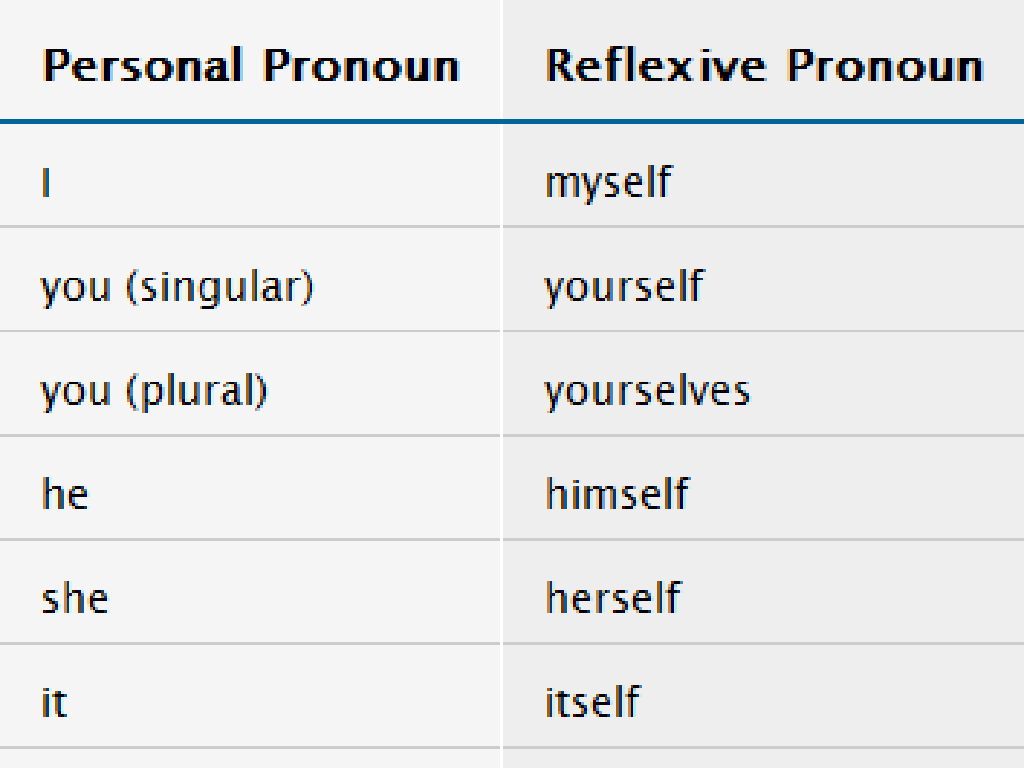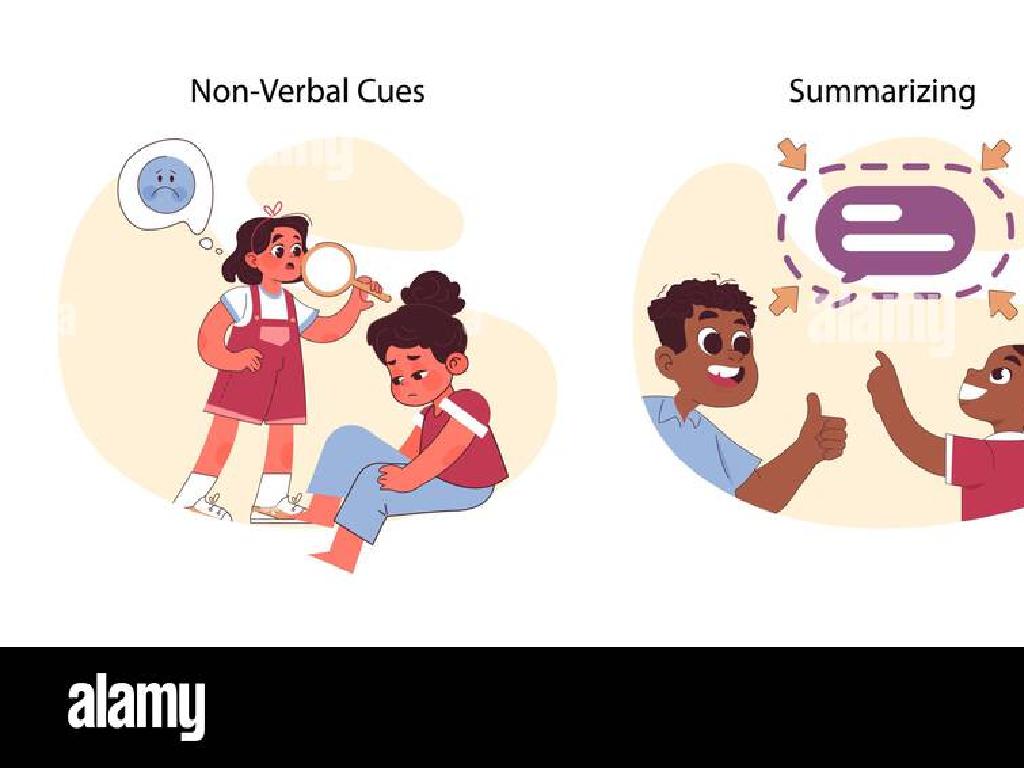Powers With Fractional Bases
Subject: Math
Grade: Sixth grade
Topic: Exponents
Please LOG IN to download the presentation. Access is available to registered users only.
View More Content
Introduction to Exponents
– Exponents represent repeated multiplication
– Power notation: base and exponent
– The base is the number being multiplied; the exponent tells how many times
– Real-life examples of exponents
– Area calculations, scientific notation, and population growth
– Practice with fractional bases
– Fractional exponents like (1/2) indicate roots, e.g., 9^(1/2) = 3
|
Begin the lesson by explaining that exponents are a shorthand for repeated multiplication. Clarify the parts of power notation, where the base is the number being multiplied, and the exponent indicates how many times the base is used as a factor. Provide real-life examples where exponents are used, such as calculating the area of squares (side^2), using scientific notation to express large numbers, or understanding exponential population growth. Introduce the concept of fractional bases by explaining that they represent roots, such as the square root or cube root, and give examples for the students to solve. This will set the foundation for understanding more complex operations with exponents.
Recap: Exponents with Whole Numbers
– Review of whole number exponents
– Understanding ‘base’ and ‘exponent’
– ‘Base’ is the number multiplied. ‘Exponent’ shows how many times.
– Solve simple exponent examples
– For example, 3^2 means 3 multiplied by itself once: 3 * 3 = 9.
– Class participation in solving
– Students will solve 2^3, 5^1, and 4^2 together in class.
|
Begin the lesson with a quick review of exponents, focusing on whole numbers to ensure a solid foundation before moving on to fractional bases. Explain the terms ‘base’ and ‘exponent’, where the base is the number being multiplied and the exponent denotes how many times the base is used in the multiplication. Work through simple examples such as 2^3, 5^1, and 4^2 with the whole class, asking students to participate and solve them. This interactive approach will help students grasp the concept of exponents with whole numbers, preparing them for understanding fractional bases in subsequent slides.
Exploring Powers with Fractional Bases
– Understanding fractional bases
– A base raised to a fraction represents a root, e.g., 9^(1/2) = 9
– Fractional vs. whole number bases
– Whole number bases result in whole numbers, while fractional bases involve roots
– Real-world fractional base examples
– Time decay in physics, or ingredient ratios in recipes
– Practice with fractional exponents
|
This slide introduces the concept of fractional bases in exponents, which is a step beyond whole number bases typically taught earlier. Fractional bases are a way of expressing roots, such as square roots or cube roots, in an exponent format. For example, a base raised to the power of 1/2 is equivalent to taking the square root of that base. It’s important to highlight the difference between whole number bases and fractional bases, as the latter introduces the concept of roots and can be connected to real-world scenarios like decay rates in science or mixing ratios in cooking. Encourage students to think of other areas where they might encounter fractional exponents. Provide practice problems to help solidify their understanding.
Powers with Fractional Bases
– Break down the fraction
– Separate the numerator and denominator
– Apply exponent to top and bottom
– Raise both numbers to the power of 3
– Example: (1/2)^3
– (1^3)/(2^3) simplifies to 1/8
|
When teaching Powers with Fractional Bases, start by explaining that a fraction consists of a numerator (top number) and a denominator (bottom number). To apply an exponent to a fraction, you raise both the numerator and the denominator to that power. Use concrete examples like (1/2)^3 to illustrate the concept. Here, both 1 and 2 are raised to the power of 3, resulting in (1^3)/(2^3), which simplifies to 1/8. This slide will help students understand how to handle exponents with fractional bases through step-by-step breakdown and practice.
Rules for Fractional Exponents
– Multiplying with same base
– Multiply exponents when bases are same: (a^(m/n)) * (a^(p/n)) = a^((m+p)/n)
– Dividing powers with same base
– Divide exponents, subtract: (a^(m/n)) / (a^(p/n)) = a^((m-p)/n)
– Raising a power to a power
– Power to a power, multiply: (a^(m/n))^p = a^(m*p/n)
|
This slide introduces the fundamental rules for working with fractional exponents, which are an extension of the laws of integral exponents. When multiplying powers with the same base, add the exponents. For dividing, subtract the exponents. When raising a power to another power, multiply the exponents. These rules are crucial for simplifying expressions with fractional exponents. Provide examples for each rule to ensure understanding. Encourage students to practice these rules with different fractional exponents to gain fluency in simplifying expressions.
Fractional Exponents: Practice Problems
– Solve problems with fractional bases
– Apply rules for fractional exponents
– Remember (a/b)^x = a^x / b^x
– Pair up for group activity
– Work together to solve and learn
– Discuss solutions as a class
– Share your methods and answers
|
This slide is designed to engage students in active practice of the concepts they’ve learned about powers with fractional bases. Start by having students solve problems individually to assess their understanding. Then, remind them of the rules for fractional exponents, such as how to handle a numerator and denominator raised to a power. The group activity should encourage collaboration and peer learning, as students pair up to work through practice problems. Finally, bring the class together to discuss the solutions, allowing students to explain their reasoning and solidify their understanding. This collaborative approach helps students learn from each other and reinforces their problem-solving skills.
Class Activity: Fractional Exponent Challenge
– Receive problem sets on fractional exponents
– Solve problems using whiteboards
– Present solutions to the class
– Discuss strategies and solutions
– Share different methods used for solving problems
|
This interactive class activity is designed to engage students with the concept of fractional exponents. Divide the class into small groups and provide each with a unique set of problems involving fractional exponents. Students will use whiteboards to work through their problems, encouraging collaboration and discussion within groups. After solving, each group will present their answers and explain their approach to the class. This will be followed by a class discussion where students can compare different strategies and clarify any misunderstandings. As a teacher, facilitate the discussion to ensure that all students understand the concept of fractional exponents and how to solve them. Possible activities could include simplifying expressions with fractional exponents, converting between radical and exponential forms, and applying the rules of exponents to simplify complex expressions.
Wrapping Up: Fractional Bases
– Recap on fractional base powers
– Homework: Practice problems
Solve assigned problems to master the concept.
– Find real-life fractional powers
Look for examples like half-life in science.
– Keep exploring and questioning
|
As we conclude today’s lesson on Powers with Fractional Bases, remind students of the key concepts covered. Emphasize the importance of practice to solidify their understanding, hence the homework assignment. Encourage them to be observant and find real-life applications of fractional exponents, such as radioactive decay (half-life) or sound intensity (decibels), to make the concept more tangible. Lastly, foster a curious mindset that prompts them to explore and ask questions about how math is intertwined with the world around them. The homework will consist of problems that gradually increase in difficulty to cater to all learning levels in the class.






